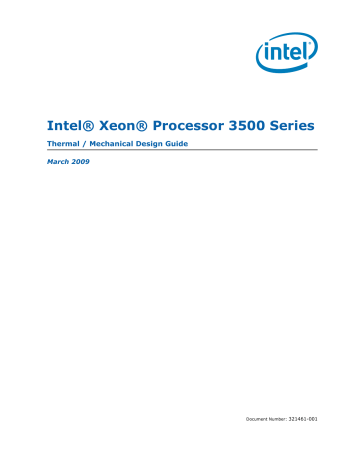- Computers & electronics
- Computer components
- System components
- Processors
- Intel
- Xeon 3500 Series
- User manual
advertisement

LGA1366 Socket and ILM Electrical, Mechanical, and Environmental Specifications
Table 4-4.
Electrical Requirements for LGA1366 Socket
Parameter
Mated loop inductance, Loop
Value
Mated partial mutual inductance, L
Maximum mutual capacitance, C.
Socket Average Contact Resistance
(EOL)
Max Individual Contact Resistance
(EOL)
Bulk Resistance Increase
Dielectric Withstand Voltage
Insulation Resistance
≤
<3.9nH
NA
<1 pF
15.2 mΩ
≤
100 mΩ
3 mΩ
360 Volts RMS
800 MΩ
Comment
The inductance calculated for two contacts, considering one forward conductor and one return conductor. These values must be satisfied at the worst-case height of the socket.
The inductance on a contact due to any single neighboring contact.
The capacitance between two contacts
The socket average contact resistance target is derived from average of every chain contact resistance for each part used in testing, with a chain contact resistance defined as the resistance of each chain minus resistance of shorting bars divided by number of lands in the daisy chain.
The specification listed is at room temperature and has to be satisfied at all time.
Socket Contact Resistance: The resistance of the socket contact, solderball, and interface resistance to the interposer land.
The specification listed is at room temperature and has to be satisfied at all time.
Socket Contact Resistance: The resistance of the socket contact, solderball, and interface resistance to the interposer land; gaps included.
The bulk resistance increase per contact from
24 °C to 107 °C
4.6
Environmental Requirements
Design, including materials, shall be consistent with the manufacture of units that meet the following environmental reference points.
The reliability targets in this chapter are based on the expected field use environment for these products. The test sequence for new sockets will be developed using the knowledge-based reliability evaluation methodology, which is acceleration factor
dependent. A simplified process flow of this methodology can be seen in Figure 4-1
.
Thermal/Mechanical Design Guide 25
LGA1366 Socket and ILM Electrical, Mechanical, and Environmental Specifications
Figure 4-1. Flow Chart of Knowledge-Based Reliability Evaluation Methodology
Establish the market/expected use environment for the technology
Develop Speculative stress conditions based on historical data, content experts, and literature search
Freeze stressing requirements and perform additional data turns
Perform stressing to validate accelerated stressing assumptions and determine acceleration factors
A detailed description of this methodology can be found at: ftp://download.intel.com/technology/itj/q32000/pdf/reliability.pdf.
§
26 Thermal/Mechanical Design Guide
advertisement
* Your assessment is very important for improving the workof artificial intelligence, which forms the content of this project
Related manuals
advertisement
Table of contents
- 7 Introduction
- 8 References
- 8 Definition of Terms
- 11 LGA1366 Socket
- 13 Board Layout
- 14 Attachment to Motherboard
- 14 Socket Components
- 14 Socket Body Housing
- 14 Solder Balls
- 15 Contacts
- 15 Pick and Place Cover
- 16 Package Installation / Removal
- 16 Socket Standoffs and Package Seating Plane
- 17 Durability
- 17 Markings
- 17 Component Insertion Forces
- 17 Socket Size
- 18 LGA1366 Socket NCTF Solder Joints
- 19 Independent Loading Mechanism (ILM)
- 19 Design Concept
- 19 ILM Cover Assembly Design Overview
- 20 ILM Back Plate Design Overview
- 20 Assembly of ILM to a Motherboard
- 23 Component Mass
- 23 Package/Socket Stackup Height
- 23 Socket Maximum Temperature
- 24 Loading Specifications
- 24 Electrical Requirements
- 25 Environmental Requirements
- 27 Sensor Based Thermal Specification Design Guidance
- 27 Sensor Based Specification Overview
- 28 Sensor Based Thermal Specification
- 28 TTV Thermal Profile
- 29 Specification When DTS value is Greater than TCONTROL
- 30 Thermal Solution Design Process
- 30 Boundary Condition Definition
- 31 Thermal Design and Modelling
- 32 Thermal Solution Validation
- 33 Fan Speed Control (FSC) Design Process
- 34 Fan Speed Control Algorithm without TAMBIENT Data
- 35 Fan Speed Control Algorithm with TAMBIENT Data
- 36 System Validation
- 37 Specification for Operation Where Digital Thermal Sensor Exceeds TCONTROL
- 39 ATX Reference Thermal Solution
- 39 Operating Environment
- 40 Heatsink Thermal Solution Assembly
- 41 Reference ATX Thermal Mechanical Design
- 42 Reference Design Components